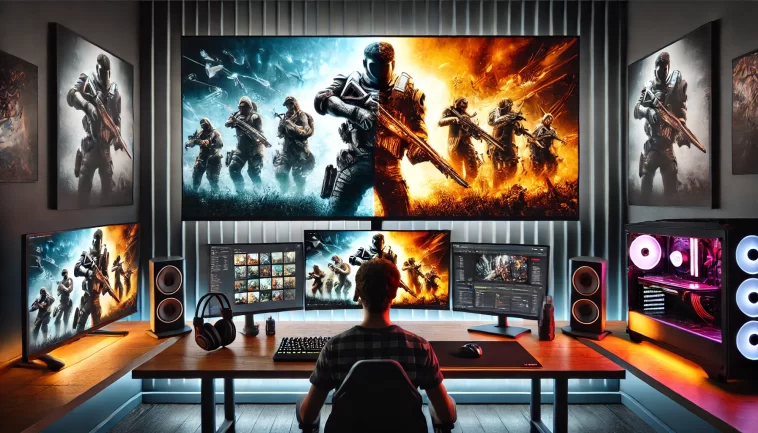Introduction
In the world of gaming, display technology is a critical factor that can significantly influence the overall experience. With the rise of advanced LCD screens, the concept of LCD conditioning has gained traction. But is LCD conditioning good for gaming? This article delves into the benefits and potential drawbacks of LCD conditioning, providing gamers with a comprehensive understanding of its impact on gaming performance and longevity.
What is LCD Conditioning?
LCD conditioning, also known as pixel refreshing or pixel calibration, is a process designed to maintain and improve the performance of an LCD screen. This technique involves running a series of patterns or colors on the screen to prevent or fix issues like image retention and pixel burnout. LCD conditioning aims to ensure that all pixels function correctly and display colors accurately.
How Does LCD Conditioning Work?
The Process of LCD Conditioning
LCD conditioning typically involves displaying specific patterns or sequences of colors that help refresh the pixels. These patterns can range from simple black-and-white screens to more complex color sequences. The goal is to stimulate each pixel to perform its duty correctly and to avoid prolonged static images that can cause retention.
Tools and Software for LCD Conditioning
There are various tools and software available for LCD conditioning. Some monitors come with built-in conditioning programs, while others rely on third-party software. These tools automate the conditioning process, making it easier for users to maintain their screens. Popular software options include JScreenFix and PixelHealer, which offer user-friendly interfaces and effective conditioning routines.
Manual vs. Automated LCD Conditioning
Manual LCD conditioning involves using patterns or test images that can be found online. Users can display these images on their screens for a set period. Automated LCD conditioning, on the other hand, uses software that runs the conditioning patterns systematically. Automated methods are generally more efficient and convenient, especially for regular maintenance.
The Benefits of LCD Conditioning for Gaming
Enhanced Color Accuracy
LCD conditioning can improve color accuracy, which is crucial for gaming. Accurate colors can enhance the visual experience, making games look more vibrant and realistic. This is particularly important in games with rich graphics and detailed environments, where color precision can significantly impact the immersion and overall enjoyment.
Prevention of Image Retention
Image retention, also known as screen burn-in, can be a significant issue for gamers who play for extended periods. LCD conditioning helps prevent this by regularly refreshing the pixels, ensuring that static images do not leave a lasting imprint. This is especially beneficial for gamers who often leave their game paused or use their monitor for multiple applications that might display static content.
Extended Lifespan of the Display
Regular conditioning can extend the lifespan of an LCD screen by preventing pixel burnout and maintaining overall screen health. This means gamers can enjoy their high-quality displays for longer periods. Investing time in LCD conditioning can thus be seen as a way to protect and prolong the life of a potentially expensive piece of gaming hardware.
Improved Gaming Experience
A well-maintained display provides a smoother and more visually pleasing gaming experience. With accurate colors, reduced image retention, and a longer-lasting screen, gamers can focus on the gameplay without being distracted by screen imperfections. This leads to a more enjoyable and immersive gaming session, whether you’re playing competitively or casually.
Potential Drawbacks of LCD Conditioning
Time-Consuming Process
LCD conditioning can be a time-consuming process, especially if done manually. Gamers who want to maintain their screens might need to dedicate time regularly to run conditioning programs. This can be seen as an inconvenience, particularly for those with busy schedules or who want to maximize their gaming time.
Not a Guaranteed Fix for All Issues
While LCD conditioning can help prevent and fix some screen issues, it is not a guaranteed solution for all problems. Severe cases of image retention or pixel damage might require professional repair or screen replacement. Understanding the limitations of LCD conditioning is important to set realistic expectations for what it can achieve.
Potential for Overuse
Excessive conditioning might not be beneficial and could potentially wear out the pixels more quickly. It’s important to follow recommended guidelines and not overuse conditioning tools. Moderation is key to ensuring that the conditioning process is effective without causing unintended damage to the screen.
Comparing LCD Conditioning with Other Display Maintenance Techniques
Pixel Shifting
Pixel shifting is another technique used to prevent image retention. It involves moving the image slightly on the screen to prevent static images from causing burn-in. This method is often used in conjunction with LCD conditioning. Pixel shifting is commonly implemented in modern monitors and televisions as a built-in feature that operates without user intervention.
Screen Savers
Screen savers can also help prevent image retention by ensuring that static images do not remain on the screen for too long. However, they are not as effective as dedicated conditioning programs. Screen savers were more prevalent in older CRT monitors, and while still useful, they might not address the root causes of pixel-related issues as effectively as LCD conditioning.
Contrast and Brightness Adjustments
Adjusting the contrast and brightness settings on your monitor can also play a role in preventing image retention. Lowering brightness and contrast during prolonged use can reduce the strain on pixels, complementing the effects of LCD conditioning. Proper calibration of these settings can enhance both the longevity and performance of the display.
Regular Breaks and Screen Usage
Taking regular breaks during extended gaming sessions can help mitigate the risk of image retention. This practice allows pixels to rest and recover, reducing the likelihood of burn-in. Combining regular breaks with LCD conditioning can provide a comprehensive approach to maintaining screen health.
Expert Opinions on LCD Conditioning for Gaming
Insights from Display Technicians
Display technicians often recommend LCD conditioning as a preventive measure. According to experts, regular conditioning can significantly reduce the risk of image retention and prolong the display’s life. Technicians emphasize the importance of using reputable software and following manufacturer guidelines to achieve the best results.
Gamers’ Experiences
Many gamers report positive experiences with LCD conditioning, noting improvements in color accuracy and reduced instances of screen burn-in. However, some also highlight the inconvenience of the time required for conditioning. Gamers who have invested in high-end displays often view conditioning as a necessary step to protect their investment.
Manufacturer Recommendations
Some monitor manufacturers include LCD conditioning features in their products and recommend regular use. These built-in tools are tailored to the specific display technology and can provide optimal conditioning routines. Following manufacturer recommendations ensures that the conditioning process aligns with the design and capabilities of the screen.
FAQs
What is LCD conditioning? LCD conditioning is a process that involves running patterns or sequences of colors on an LCD screen to maintain its performance and prevent issues like image retention.
How often should I perform LCD conditioning on my gaming monitor? It depends on your usage patterns. For heavy gaming, performing LCD conditioning once a month is generally recommended.
Can LCD conditioning fix screen burn-in? LCD conditioning can help prevent screen burn-in and reduce its effects, but it may not completely fix severe burn-in cases.
Is LCD conditioning necessary for all types of monitors? LCD conditioning is specifically beneficial for LCD screens. Other types of displays, such as OLEDs, may have different maintenance requirements.
What are the best tools for LCD conditioning? There are several tools available, including built-in programs on some monitors and third-party software like JScreenFix and PixelHealer.
Does LCD conditioning affect gaming performance? LCD conditioning does not directly affect gaming performance but helps maintain the display’s quality, ensuring a better visual experience.
Can I use my monitor while running LCD conditioning? It’s best to avoid using the monitor during conditioning to allow the process to work effectively. Running it during off-hours or overnight can be convenient.
Are there any risks associated with LCD conditioning? When done correctly, LCD conditioning poses minimal risk. However, excessive or improper use might strain the pixels, so it’s important to follow guidelines.
How do I know if my monitor needs conditioning? Signs like persistent image retention, color inaccuracies, or a decrease in display quality indicate that your monitor might benefit from conditioning.
Is LCD conditioning covered under warranty? This depends on the manufacturer’s policy. Some warranties might cover screen maintenance issues, while others might not. Check your warranty details for specifics.
Conclusion
Is LCD conditioning good for gaming? The answer largely depends on individual preferences and the specific needs of your display. While it offers significant benefits like enhanced color accuracy, prevention of image retention, and extended lifespan of the display, it also comes with some drawbacks, such as the time required for the process. Gamers who prioritize maintaining the quality of their screens may find LCD conditioning a worthwhile investment, contributing to a more immersive and enjoyable gaming experience.
In the end, maintaining your gaming setup involves a combination of practices, and LCD conditioning is one valuable tool in that arsenal. By understanding its benefits and limitations, you can make an informed decision about how to best care for your display and enhance your gaming sessions.


